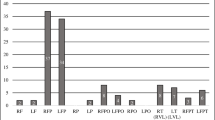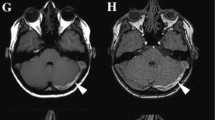Abstract
Purpose
Accurate assessment of dural sinus, deep and cortical venous thrombosis on MR imaging is challenging. The aim of this study is to evaluate the accuracy of 3D-T1 turbo spin echo (T1S), sequences in detecting venous thrombosis and comparing it with susceptibility-weighted imaging (SWI), magnetic resonance venography (MRV) and post contrast T1 magnetization-prepared rapid acquisition gradient echo (T1C).
Methods
A blinded retrospective observational analysis of 71 consecutive patients evaluated for cerebral venous thrombosis (CVT) and 30 control patients was performed. Multimodality reference standard adopted included T1C, SWI with MRV. Sub-analyses in superficial, deep and cortical venous segments were performed in addition to correlation of signal intensity of thrombus with the clinical stage.
Results
A total of 2222 segments in 101 complete MRI examinations were evaluated. Sensitivity/specificity/positive predictive value/negative predictive value/accuracy and precision of T1S for detection of cortical vein thrombosis was 0.994/1/1/0.967/0.995/1, 1/0.874/0.949/1/0.963/0.950 for detection of superficial venous sinus thrombosis and 1/1/1/1/1/1 for deep venous thrombosis. The AUC yield for T1S was 0.997 for cortical, 1 for deep and 0.988 for superficial venous segments.
Conclusion
T1S paralleled the accuracy of conventional sequences in the overall detection of CVT but showed superior accuracy in the detection of cortical venous thrombosis. It makes a fitting addition to the CVT MRI protocol in scenarios demanding negation of gadolinium administration.




Similar content being viewed by others
Data availability
Data is available with the corresponding author and may be provided on reasonable request.
References
Saposnik G, Barinagarrementeria F, Brown RD, Bushnell CD, Cucchiara B, Cushman M et al (2011) Diagnosis and management of cerebral venous thrombosis: a statement for healthcare professionals from the American Heart Association/American Stroke Association. Stroke 42(4):1158–1192. https://doi.org/10.1161/STR.0b013e31820a8364
Riva N, Ageno W (2018) Clinical manifestations and imaging tools in the diagnosis of splanchnic and cerebral vein thromboses. Thromb Res 163:252–259. https://doi.org/10.1016/j.thromres.2017.06.030
Yang Q, Duan J, Fan Z, Qu X, Xie Y, Nguyen C et al (2016) Early detection and quantification of cerebral venous thrombosis by magnetic resonance black-blood thrombus imaging. Stroke 47(2):404–409. https://doi.org/10.1161/STROKEAHA.115.011369
Niu P-P, Yu Y, Guo Z-N, Jin H, Liu Y, Zhou H-W et al (2016) Diagnosis of non-acute cerebral venous thrombosis with 3D T1-weighted black blood sequence at 3T. J Neurol Sci 367:46–50. https://doi.org/10.1016/j.jns.2016.05.052
Al-Smadi AS, Abdalla RN, Elmokadem AH, Shaibani A, Hurley MC, Potts MB, Jahromi BS, Carroll TJ, Ansari SA (2019) Diagnostic accuracy of high-resolution black-blood MRI in the evaluation of intracranial large-vessel arterial occlusions. Am J Neuroradiol 40(6):954–959. https://doi.org/10.3174/ajnr.A6065
Yang Q, Fan Z, Bi X, Li D (2016) Early detection and quantification of cerebral venous thrombosis by Magnetic Resonance Black Blood Thrombus Imaging (MRBTI). J Cardiovasc Magn Reson 18(1):1–2. https://doi.org/10.1161/STROKEAHA.115.011369
Murumkar V, Goyal S, Priyadarshini Baishya P, Peer S, Lanka V, Kulanthaivelu K et al (2021) Isolated thrombosis of cortical veins – clinical and radiological correlation. J Clin Neurosci 91:369–377. https://doi.org/10.1016/j.jocn.2021.07.018
Linn J, Michl S, Katja B, Pfefferkorn T, Wiesmann M, Hartz S et al (2010) Cortical vein thrombosis: the diagnostic value of different imaging modalities. Neuroradiology 52(10):899–911. https://doi.org/10.1007/s00234-010-0654-0
Fellner FA, Fellner C, Aichner FT, Mölzer G (2005) Importance of T2*-weighted gradient-echo MRI for diagnosis of cortical vein thrombosis. Eur J Radiol 56(2):235–239. https://doi.org/10.1016/j.ejrad.2005.05.010
Hu HH, Campeau NG, Huston J, Kruger DG, Haider CR, Riederer SJ (2007) High-spatial-resolution contrast-enhanced MR angiography of the intracranial venous system with fourfold accelerated two-dimensional sensitivity encoding. Radiology 243(3):853. https://doi.org/10.1148/radiol.2433060819
Linn J, Ertl-Wagner B, Seelos KC, Strupp M, Reiser M, Brückmann H et al (2007) Diagnostic value of multidetector-row CT angiography in the evaluation of thrombosis of the cerebral venous sinuses. AJNR Am J Neuroradiol 28(5):946–952
Meckel S, Reisinger C, Bremerich J, Damm D, Wolbers M, Engelter S et al (2010) Cerebral venous thrombosis: diagnostic accuracy of combined, dynamic and static, contrast-enhanced 4D MR venography. Am J Neuroradiol 31(3):527–535. https://doi.org/10.3174/ajnr.A1869
Liang L, Korogi Y, Sugahara T, Ikushima I, Shigematsu Y, Takahashi M, Provenzale JM (2002) Normal structures in the intracranial dural sinuses: delineation with 3D contrast-enhanced magnetization prepared rapid acquisition gradient-echo imaging sequence. Am J Neuroradiol 23(10):1739–1746
Boukobza M, Crassard I, Bousser MG, Chabriat H (2009) MR imaging features of isolated cortical vein thrombosis: diagnosis and follow-up. AJNR Am J Neuroradiol 30(2):344–348. https://doi.org/10.3174/ajnr.A1332
Farb RI, Scott JN, Willinsky RA, Montanera WJ, Wright GA (2003) terBrugge KG. Intracranial venous system: gadolinium-enhanced three-dimensional MR venography with auto-triggered elliptic centric-ordered sequence--initial experience. Radiology 226(1):203–209. https://doi.org/10.1148/radiol.2261020670
Urban PP, Müller-Forell W (2005) Clinical and neuroradiological spectrum of isolated cortical vein thrombosis. J Neurol 252(12):1476–1481. https://doi.org/10.1007/s00415-005-0893-x
Idbaih A, Boukobza M, Crassard I, Porcher R, Bousser MG, Chabriat H (2006) MRI of clot in cerebral venous thrombosis: high diagnostic value of susceptibility-weighted images. Stroke 37(4):991–995. https://doi.org/10.1161/01.STR.0000206282.85610.ae
Battal B, Sari S, Hamcan S, Akgun V (2014) Susceptibility-weighted imaging in the diagnosis of isolated cortical vein thrombosis. Eur Neurol 71(1–2):57–58. https://doi.org/10.1159/000355942
Mittal S, Wu Z, Neelavalli J, Haacke EM (2009) Susceptibility-weighted imaging: technical aspects and clinical applications, Part 2. Am J Neuroradiol 30(2):232–252. https://doi.org/10.3174/ajnr.A1461
Boukobza M, Crassard I, Bousser M-G, Chabriat H (2016) Radiological findings in cerebral venous thrombosis presenting as subarachnoid hemorrhage: a series of 22 cases. Neuroradiology 58(1):11–16. https://doi.org/10.1007/s00234-015-1594-5
Coutinho JM, Ferro JM, Canhão P, Barinagarrementeria F, Cantú C, Bousser M-G et al (2009) Cerebral venous and sinus thrombosis in women. Stroke 40(7):2356–2361. https://doi.org/10.1161/STROKEAHA.108.543884
Wang G, Yang X, Duan J, Zhang N, Maya MM, Xie Y, Bi X, Ji X, Li D, Yang Q, Fan Z (2019) Cerebral venous thrombosis: MR black-blood thrombus imaging with enhanced blood signal suppression. Am J Neuroradiol 40(10):1725–1730. https://doi.org/10.3174/ajnr.A6212
Li L, Miller KL, Jezzard P (2012) DANTE-prepared pulse trains: a novel approach to motion-sensitized and motion-suppressed quantitative magnetic resonance imaging. Magn Reson Med 68:1423–1438. https://doi.org/10.1002/mrm.24142
Author information
Authors and Affiliations
Corresponding author
Ethics declarations
Competing interests
The authors declare that they have no conflict of interest.
Additional information
Publisher’s note
Springer Nature remains neutral with regard to jurisdictional claims in published maps and institutional affiliations.
Supplementary information
ESM 1
(DOCX 2646 kb)
Rights and permissions
Springer Nature or its licensor (e.g. a society or other partner) holds exclusive rights to this article under a publishing agreement with the author(s) or other rightsholder(s); author self-archiving of the accepted manuscript version of this article is solely governed by the terms of such publishing agreement and applicable law.
About this article
Cite this article
Ahmed, S., Arora, A., Kulanthaivelu, K. et al. Utility of 3D T1-weighted turbo spin echo black blood sequence for the diagnosis of cerebral venous thrombosis. Emerg Radiol 30, 443–451 (2023). https://doi.org/10.1007/s10140-023-02150-9
Received:
Accepted:
Published:
Issue Date:
DOI: https://doi.org/10.1007/s10140-023-02150-9




